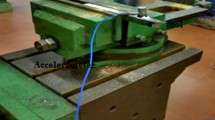Abstract
The assessment of actual cutting forces is vital and essential task for the design and analysis of structural systems. The present study deals with experimental investigation of cutting forces during machining, considering the initial impact during the engagement of cutting tool and work piece. The cutting forces are studied on HSS tool and carbon steel work piece for various cutting parameters. Cutting force assessment directly during machining is a complex task, while the responses because of these forces can be measured using a sensor. The impact cutting force identification on end mill tool is investigated using inverse technique with the aid of frequency response function which measures the structural responses. Experimentally predicted cutting forces are compared with analytically determined cutting forces. Finite element analysis of end mill tool is conceded subjected to the cutting forces to estimate the induced stress, and using induced stress the fatigue life of end mill tool is predicted. The results show that experimental cutting forces predicted are in close agreement with the analytically determined cutting forces. The significance level of the experimental method is 99% having 1% error. Impact effect of cutting forces observed is in the range of 1.093–1.409 than the average cutting force. Cutting tools designed using average cutting force provides false picture of tool life and must be predicted using actual cutting forces.















Similar content being viewed by others
References
Adams R, Doyle JF (2002) Multiple force identification for complex structures. Exp Mech 42(1):25–36
Arabatti VV, Arvind BM et al (2015) Production technology handbook, HMT. McGraw Hill, New York, pp 193–202
Baburaj M, Ghosh A, Shunmugam MS (2018) Development and experimental validation of a mechanistic model of cutting forces in micro-ball end milling of full slots. Mach Sci Technol 22:787–810
Boukria Z, Perrotin P, Bennani A (2011) Experimental impact force location and identification using inverse problems: application for a circular plate. Int J Mech 5(1):48–55
Ding Y, Law SS, Wu B, Xu GS, Lin Q, Jiang HB, Miao QS (2013) Average acceleration discrete algorithm for force identification in state space. Eng Struct 56:1880–1892
Gunawan FE (2012) Levenberg–Marquardt iterative regularization for the pulse-type impact-force reconstruction. J Sound Vib 331:5424–5434
Gupta DK, Dhingra AK (2015) Load reconstruction technique using D-optimal design and markov parameters. Shock Vib 2015:1–9
Huang H, Pan J, Mccormick PG (1997) Prediction of impact forces in a vibratory ball mill using an inverse technique. Int J Impact Eng 19(2):117–126
Jacquelin E, Bennani A, Hamelin P (2003) Force reconstruction: analysis and regularization of a deconvolution problem. J Sound Vib 265:81–107
Khoo SY, Ismail Z, Kong KK, Ong ZC, Noroozi S, Chong WT, Rahman AGA (2014) Impact force identification with pseudo-inverse method on a lightweight structure for under-determined, even-determined and over-determined cases. Int J Impact Eng 63:52–62
Kim S-J, Lee S-K (2008) Experimental identification for inverse problem of a mechanical system with a non-minimum phase based on singular value decomposition. J Mech Sci Technol 22:1504–1509
Liu Y, Shepard WS Jr (2005) Dynamic force identification based on enhanced least squares and total least-squares schemes in the frequency domain. J Sound Vib 282:37–60
Liu Y, Shepard WS Jr (2006) An improved method for the reconstruction of a distributed force acting on a vibrating structure. J Sound Vib 291:369–387
Ma C-K, Ho C-C (2004) An inverse method for the estimation of input forces acting on non-linear structural systems. J Sound Vib 275:953–971
Martin MT, Doyle JF (2003) Impact force identification from wave propagation responses. J Imp Eng 18(1):65–77
Patil RA, Gombi SL (2018) Experimental study of cutting force on a cutting tool during machining using inverse problem analysis. J Braz Soc Mech Sci Eng 40:494
Wang B-T (2002) Prediction of impact and harmonic forces acting on arbitrary structures: theoretical formulation. Mech Syst Signal Process 16(6):935–953
Zhang X, Ehmann KF, Tianbiao Yu, Wang W (2016) Cutting forces in micro-end-milling processes. Int J Mach Tools Manuf 107:21–40
Author information
Authors and Affiliations
Corresponding author
Rights and permissions
About this article
Cite this article
Patil, R.A., Gombi, S.L. Operational Cutting Force Identification in End Milling Using Inverse Technique to Predict the Fatigue Tool Life. Iran J Sci Technol Trans Mech Eng 46, 31–41 (2022). https://doi.org/10.1007/s40997-020-00388-z
Received:
Accepted:
Published:
Issue Date:
DOI: https://doi.org/10.1007/s40997-020-00388-z




